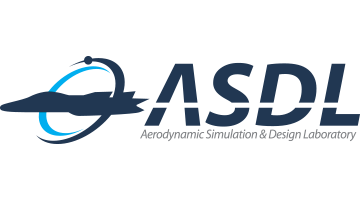ASDL 연구팀, Journal of Aircraft 학술지 논문 게재
ASDL 연구팀에서 Journal of Aircraft 학술지에 online article in advance로 게재하였던 논문이 2024년 3월자로 게재되었습니다. 축하합니다!
Title: Design Optimization of Lambda-Wing Planform and Vortex Generators for Longitudinal Instability Alleviation
Author: Seonguk Lee and Chongam Kim
Journal: Journal of Aircraft
DOI: https://doi.org/10.2514/1.C037495
Abstract:
This paper focuses on optimizing the planform and vortex generators (VGs) to improve longitudinal stability of the lambda-wing aircraft by alleviating pitchup. The optimizations are performed in two stages using a Reynolds-averaged Navier–Stokes (RANS) solver that can accurately capture the vortical flow structure, affecting the pitchup. First, the planform configuration is optimized to minimize the rise in the pitching moment while maintaining aerodynamic and stealth performances. The designed planform delays the pitchup by 4 deg and increases the usable lift by 31% due to the leading-edge vortex (LEV) flow over the outboard wing. Second, the VGs are installed and optimized to reduce the sudden increase in the pitching moment at high angles of attack. The designed VGs partially eliminate the separated flow and recover the LEV on the outboard wing, suppressing the radical change in the pitching moment by 75%. Some quantitative difference in aerodynamic coefficients is observed in unsteady RANS computations, but the vortical flow unsteadiness minimally affects the flow structure, and the stability improvement remains over 80%. Overall, the generation and sustainability of the LEV are critical aerodynamic factors to secure longitudinal stability in designing the lambda-wing aircraft.
Title: Design Optimization of Lambda-Wing Planform and Vortex Generators for Longitudinal Instability Alleviation
Author: Seonguk Lee and Chongam Kim
Journal: Journal of Aircraft
DOI: https://doi.org/10.2514/1.C037495
Abstract:
This paper focuses on optimizing the planform and vortex generators (VGs) to improve longitudinal stability of the lambda-wing aircraft by alleviating pitchup. The optimizations are performed in two stages using a Reynolds-averaged Navier–Stokes (RANS) solver that can accurately capture the vortical flow structure, affecting the pitchup. First, the planform configuration is optimized to minimize the rise in the pitching moment while maintaining aerodynamic and stealth performances. The designed planform delays the pitchup by 4 deg and increases the usable lift by 31% due to the leading-edge vortex (LEV) flow over the outboard wing. Second, the VGs are installed and optimized to reduce the sudden increase in the pitching moment at high angles of attack. The designed VGs partially eliminate the separated flow and recover the LEV on the outboard wing, suppressing the radical change in the pitching moment by 75%. Some quantitative difference in aerodynamic coefficients is observed in unsteady RANS computations, but the vortical flow unsteadiness minimally affects the flow structure, and the stability improvement remains over 80%. Overall, the generation and sustainability of the LEV are critical aerodynamic factors to secure longitudinal stability in designing the lambda-wing aircraft.






